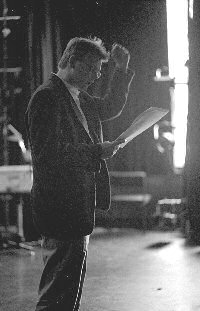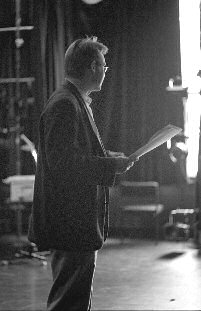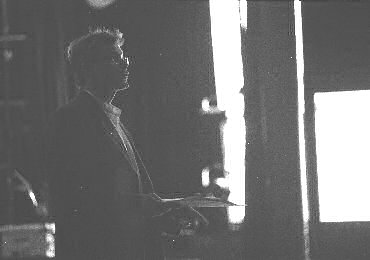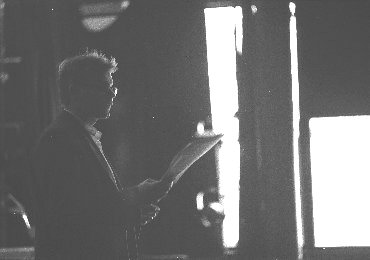 Virtuosity and Performance
Mastery issue, 2003/04
Virtuosity and Performance
Mastery issue, 2003/04
Virtuosity in Musical Composition
Copyright © Peter Fribbins 2003.
(No part of this text may be reproduced without the written permission of the author.)


This material was presented live at the Virtuosity and Performance Mastery symposium for postgraduate/research degree students and academic staff over two days by Performing Arts at Middlesex University on 31st May and 1st June 2003.
In music, the term virtuosity has many connotations and associations, normally in the context of performance, and especially in nineteenth century music. But can it ever have a meaning when applied to the production or creation of music independent of its execution? Can there be a sense in which composition may be viewed as virtuosic?
If our concept of virtuosity is mostly connected to nineteenth century performance practices, then implicitly we find ourselves tangled with gender issues in art, since nineteenth century musical virtuosity espouses mainly masculine values and its exponents were generally male. (1) Even in the eighteenth century there were performance duels or competitions to prove the best or strongest performer - for instance the famous case between Mozart and Clementi on Christams Eve 1781 before Joseph II in his Viennese Court. (2)

One also thinks of Renaissance painting and portraiture: ladies play the harp or gentle keyboard instruments like the spinet, and are never shown playing wind instruments, since the puffing out of the cheeks, and the resulting perspiration from exertion was considered un-lady-like. Hence historically, if we examine musical virtuosity we seem to be dealing with the predominantly masculine values of bravura, stamina, agility and showmanship (conspicuously absent in English seems the word showwomanship). In other words, all the attributes of the battlefield are sanitised (sometimes stylised alla marcia) for the concert hall. This is particularly acute in the nineteenth century concerto where the heroic soloist, Flash Gordon-like is pitted against the overwhelming odds of the Romantic orchestra.
Can we detect similar values of musical virtuosity in musical composition? This is complex, since one first must deal with the difference between the creator and executor in music, which in one sense is entirely artificial. Artificial, since the division between the two is fairly recent, dating from approximately the end of the first millennium AD, or in music scholarship, the early medieval period. Until then, the performer was the composer. Western musical notation facilitated the division, enabling the newly defined composer to create more complex musical structures, replacing much of the performer's improvised virtuosity with the pre-conceived virtuosity mapped out by another party, pulling the strings as it were, from behind. (And by the nineteenth century, with the composer elevated to the position of omniscient genius and virtual god, from above).
So can the puppeteer be a virtuoso too? In musical composition as in all artistic creation, there is a clear schizophrenic tendency as one moves in the mind continuously between creator and executor phases, building something, a theme, a phrase, a series of harmonies and then quietly trying them out, thinking through them or sometimes (if appropriate) even playing them on the piano. Thus one creates a virtual performance divorced from an audience (apart from oneself) and a concert hall, and the creator/executor division in a pure sense is already somewhat confused in the very process of composition. The composer at one level is his/her own performer, and part of the satisfaction in composing (for me) is curiously to build structures that already have a virtual performance in the composer's mind. How the performer as musical executor should relate to the composer as virtual performer is a vexed question of course, and I do not want to get bogged down with that here. Clearly in order for a performance to be satisfying and effective, the performer must create their own artefact from the composer's work (now a case of the performer as virtual composer) and in some of the most memorable performances a performer gives the illusion that they are the composer, improvising the music on the spot. So the whole process and history of composer/executor division curiously comes full circle in the work of the best performers. During that phase of the process I see my role as a composer, primarily one of not getting in the way (is this perhaps why western societies prefer their composers to be dead?)
So there is clearly a strong overlap between composer and performer, and in examining the question of virtuosity in composition, we are partly (and paradoxically) concerned with the composer's virtual performance in the process of composition. After all, any virtuosity in the composition cannot be heard without the virtuosity of the performer. One facilitates the other and virtuosic compositional technique ultimately merely equips the performer for the most important task of conjuring the music to life at that moment, ideally in an improvisational spirit. (3)

So what do we actually mean by compositional virtuosity? - A compositional sense of technical virtuosic display or mastery in the context of that art or practice in a similar or parallel sense to that of the performer. As a composer, I am not trying to steal limelight from the performer, but I am aware that the composer as an artist also must possess appropriate technique, stamina, technical agility etc. in order to be a master of their art. This is better perceived in the finished artefact (either score or performance) rather than in the process (in as much as one can separate the process from the finished result of course). So in the context of the above difficulties and qualifications, I would like to offer the following four categories of virtuosity in musical composition:
Virtuosity of technique in managing complexity
The music of Ferneyhough, James Dillon and other 'new complexity' composers (apologies for the rather 1980s term) is a good example of this sense of compositional virtuosity. There is a strong link with the Romantic/nineteenth century sense of the performer's virtuosic display. This is logical, since there is a strong connection between 20th (and 21st) century modernism and the implicit modernist values in nineteenth century music. A composer like Richard Strauss (1864-1949) is a worthy nineteenth century/Romantic predecessor in this sense: the showmanship in managing large and complex musical orchestration (perhaps even somewhat macho, or certainly masculine) would seem to have a direct correlation.
This partly relates to:
Virtuosity of stamina and endurance
Again aesthetically rather masculine: an ability to mentally manage, map out and then survive large-scale musical forms is another nineteenth century inheritance. One thinks of Beethoven's treatment of the graceful classical symphonic form inherited from Haydn and Mozart, virtually doubling its length from c.20 minutes to 40 minutes of wilful, wild passion in his Eroica ('Heroic') Symphony of 1803. Performers increasingly complained about the difficulty of Beethoven's music throughout that decade and the next. The ninth symphony (1822-24) is the epitome of this tendency, a vast musical structure using huge orchestra and choir at the same time (a sort of Brunel's suspension bridge in sound). Schubert's ninth symphony was similarly vast, these examples then taken up by composers like Mahler, Strauss in his epic symphonic poems and Shostakovich (particularly the fifth symphony). Nicholas Maw's vast orchestral work Odyssey, recorded by Simon Rattle on two CDs is a more recent example form the late 1980s.
Virtuosic reference to and use of other musical works
I am particularly thinking of 'quotation' works of the 1960s and '70s, with perhaps the most famous example being the late Luciano Berio's Sinfonia (1968). Within the framework of the Scherzo from Mahler's 2nd Symphony (already a virtuosic piece in cases 1 and 2 above) Berio interweaves literary hundreds of musical and literary references - a real tour de force in one of the original meanings of the virtu in virtuosity: love, reverence and a special knowledge for art. Berio certainly displays this in abundance.
A similar sense of using the past and building new musical works and meanings upon it can be found in medieval music of course. Not only the concept of troping on existing musical works, but in motets, creating complex polyphony around a cantus firmus of simple pre-existing liturgical chant: a real virtuosic compositional display, giving new comment on the old. Perhaps 14th century composers of the complex isorhythmic style were some of the first postmodernists?
Virtuosity of technique within limited resources or material
One of my favourites: a mental challenge, related to case 1 above in a sense, but far away from the conspicuous aesthetic masculinity of both 1 and 2. In the 1960s, Berlin composer Boris Blacher would give his students exercises designed to improve their compositional technique by giving them compositional tasks within very stringent resources, for instance 'write a piece for solo snare drum.'
On one level I am glad I did not have such a teacher, although I have partaken in these games of mental prowess on occasions: the fourth movement of my wind quintet In Xanadu (4) for instance, is scored for only clarinet, horn and bassoon, and uses only the pitches C,B,F# and G in different linear and vertical permutations. I was very pleased with it at the time. (5)
The first of Ligeti's Ricercare for piano (1953) relies on a similar strategy, although here the composer has the virtuosic temerity to rely on only one note!
A similar aesthetic is present in composers such as J.S. Bach and Bartok who delight in difficult contrapuntal composition or in writing fiendishly clever fugues. But theirs is often a personal rather than public world, the aesthetic is internalised, cerebral and distant, a rather private virtuosity perhaps.
Peter Fribbins, May 2003
Notes
1 The situation corrected in the twentieth century: there are many women virtuosi performers today.
2 Mozart, clearly rattled by this worthy opponent later said in a letter to his father; 'Clementi is a charlatan, like all Italians.'
3 One of the problems with the nineteenth development of the musical canon is that concert hall pieces are now so well known that any illusion of the improvisation is lost to an audience.
4 1991. Recorded: Serendipity, SERCD2000, 1992.
5 Runner-up in the Royal Philharmonic Society Prize, 1992.
Peter Fribbins is a composer whose work is performed regularly throughout the UK and abroad. Several of his works have been released on CD with much success - most notably Porphyria's Lover and In Xanadu. I Have the Serpent Brought is frequently programmed by string quartets; and the Allegri Quartet will tour his Clarinet Quintet in its 50th anniversary season in 2004. The new violin and piano work that which echoes in eternity is based upon a quotation from Dante's Inferno and was premiered on London's South Bank in April 2003. Peter is also Programme Leader for BA Music and Artistic Director of the celebrated London Chamber Music Society concerts based at the Conway Hall.
Last updated 30th August 2004.
Black and white photography © John Robinson, 2003.